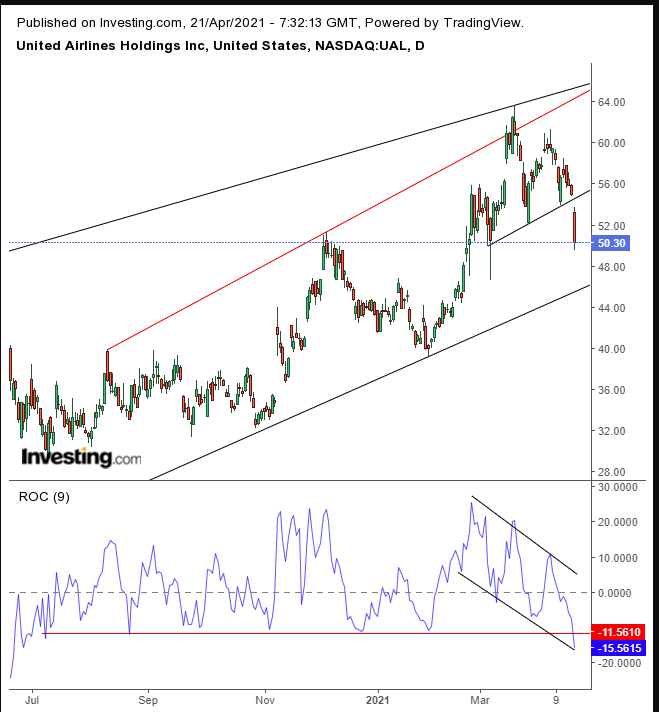United Airlines Holdings (NASDAQ:UAL) reported first quarter 2021 earnings on Monday and the results weren't pretty. The release revealed both a worse-than-expected $1.36 billion loss, and a lower than expected EPS of -$7.5.
Perhaps, though, that wasn’t what provoked investors to unload the stock on Tuesday, at up to an 8.5% loss.
Forward-looking investors are more concerned with what's ahead for the passenger carrier than for what's already happened. The company's guidance indicated that the airline doesn’t expect business conditions to change in the immediate futures.
According to CEO Scott Kirby's remarks during the earnings call, UAL anticipates that the bulk of travel will only begin to recover in 2022. He pointed out that businesses generally set their travel budgets at the beginning of the year and with vaccination efforts in flux at the start of 2021, most didn't allocate significant funding to business travel.
Investors reacted strongly to the weak guidance and simply dumped the stock.

Shares were already displaying weakness before the report. That was evident both when the price topped out on Apr. 7 below the Mar. 18 peak, and when the momentum indicator provided a negative divergence, falling as the price was rising.
When stocks move before the fundamentals are known, it's often an indication that 'Informed Money'—a close circle of people who were in some way connected to the company's situation—might have picked up on innuendo about the fundamentals that may have stemmed from the decision makers within that circle.
When the known fundamentals were published on Monday, in the form of earnings and guidance, the broader public reacted, helping push the price even lower, below the neckline of an H&S top.
Currently, momentum has fallen to the lowest level since the rising channel began, suggesting the price will not find the support at its bottom.
Note, the H&S is within a rising channel, which means that the price can find support at its bottom, which may propel the stock back up. Therefore, until the channel breaks, we expect the price to resume on its current course, meaning higher in the medium-term (until proven otherwise, with the channel break) and lower, toward the channel bottom, in the short term.
If you look at the chart, you can see that’s tricky to navigate. So, here are some things to look out for:
Trading Strategies
Conservative traders should wait for the price to find support at the channel bottom, before joining the uptrend.
Moderate traders would short if the price performs a return move that confirms the neckline’s resistance.
Aggressive traders could short at will, before joining the market upon a rebound, provided they understand and accept the higher risk that goes with the higher rewards when moving before the rest of the market. Money management is key. Here’s a basic example:
Trade Sample
- Entry: $50
- Stop-Loss: $51
- Risk: $1
- Target: $46
- Reward: $4
- Risk:Reward Ratio: 1:4
Author's Note: This is only a sample. There are other ways to weigh the outcome probabilities. For example, waiting for a corrective rally, as described for moderate traders, which would limit the chances of whipsaw but at the price of increasing the odds of missing the trade. We don’t recommend having a target below the channel, which may support the price; you want to operate on the side of statistics, not against them.
There are many ways to approach a trade. You need to customize a plan to your timing, budget and temperament. Until you learn how to do so, you can follow our guidance, but for the purpose of learning. If you think you’ll make bank following generic trade plans, you will go bankrupt. Oh, and you’ll never become a trader.
